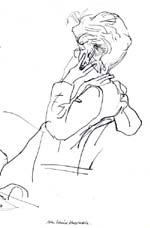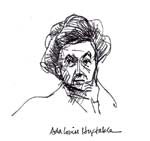
|

|
|
Home Site Search Contact Us Subscribe
|
|
|
Laurie Olin Remembers Ada Louise Huxtable, Champion of Urban Design With eloquence, grace, and warmth, the master landscape architect shares his personal encounters with the most notable of critics. By Laurie Olin, FASLA February 5, 2013 Editor’s note: We came across this beautiful, personal tribute on the OLIN blog and, with Laurie Olin’s permission, we reprint it here. It made us smile. We hope it does the same for you.
Ada Louise Huxtable was a formidable figure, one whose writing and commentary was always informed, thoughtful, and delivered without the jargon that so often plagues architecture and art criticism. She was the epitome of clarity and common sense with an equal devotion to the highest aesthetic standards and the most democratic social view.
Ada Louise was a fierce champion of urban design that engendered community and life on the street. Like her contemporary and fellow New Yorker Jane Jacobs, she was fierce in her loyalties and enmities, and she didn’t suffer fools, lax or corrupt politicians, or smarmy designers. Unswayed by fashion, she stuck her neck out for work that she deemed exemplary, whether others liked it or not. Unlike some critics who have followed her in the field, Ada Louise didn’t limit herself to reviewing only new, high-style buildings, but took a broader perspective, especially regarding urban design and city planning, even occasionally landscape. She had an unerring eye and ear, pioneer of mainstream newspaper architecture criticism.
Like many in my generation, I discovered her when I moved to New York and began reading the New York Times in the 1960s. I always wondered what she would write about next, and I looked forward to her tart but insightful remarks. One of her favorite targets was Robert Moses, the famed, sometimes notorious, urban planner whose legacy of highways, bridges, and tunnels had for so long provided him inroads to New York’s power politics and public authorities. Ada Louise wasn’t impressed by his bravado and bluster, and she let her readers know that they could think the same.
No one was more unforgiving about mistakes in high places. She was unforgiving and unrelenting in her opposition to the destruction of Penn Station, the piling of tens of millions of square feet on top of Grand Central Terminal, and the destruction of the view down Park Avenue with the galumphing Pan Am (now MetLife) building. On the other hand, she was a champion of elegant modern works, brushing aside frightened and stodgy sorts who couldn’t bear shiny new structures among the polite, sedate, or merely mediocre acres of Manhattan’s repetitive landscape. Seagram, Lever House, Chase Manhattan, and the Ford Foundation got her juices going, and she wrote vigorously about them.
She turned out articles regularly without many slack moments. After a time, she published several collections of her columns under titles like, Will They Ever Finish Bruckner Boulevard? (1989), and Kicked a Building Lately? (1989). An urge to develop a more sustained line of speculation and critical thought led her to write The Tall Building Artistically Reconsidered (1993), and Frank Lloyd Wright, A Life (2008), among others. There was a Huxtable style – an ability to write or turn a phrase that one remembers as much for the words as for the penetrating observations. Regarding Harry Cobb’s once troubled John Hancock building in Boston, she wrote that, “of all the skyscrapers it was the ‘scrape-iest.’” It is absolutely true. One of the very first all reflective-glass buildings, it is still one of the absolute best, with its beautiful reflections of sky within the sky and its oh-so-tight skin, sharp corners, and notches. It outdoes all the minimalist artists and color field painters from the 1960s to the 1990s. Ada Louise Huxtable saw the Hancock building’s merits, even though, she acknowledged, it isn’t a very friendly skyscraper at the ground level but for the unexpected reflections of Trinity Church across the street. Her writing made you think and critically compare your thoughts with her judgments.
For a few years after I stepped down as Chairman of the Landscape Architecture Department at Harvard University, I served on the Visiting Committee at Harvard’s Graduate School of Design. Ada Louise was also on the committee. Her presence helped to ensure that one wouldn’t miss meetings, if for no other reason than to have the pleasure of watching her debate Dean Gerald McCue and other captains of industry regarding their endeavors and motives. She was equally interested in the young unknowns we were educating as she was in all the world-famous people she regularly encountered. What were we doing about our students’ understanding and concern for communities, and the lives of those who would use the places that these future landscape architects would craft? What were we doing about financial aid and the horrific cost of a degree, and the economic mix and background of our admissions? As usual, she went for the important issues.
A few years later, she and I were appointed to a four-person jury to select a winner for a new award, The Prince of Wales Prize for Municipal Heritage Leadership. We each submitted several names and then met to discuss them. After a time, two entries rose to the top, but it quickly became evident that she and I were reluctant to give up either of the candidates. She asked, couldn’t we just give them both the prize? Why not? Who could say no to Ada Louise? So we awarded the prize to both Ralph Erskine and Alvaro Siza. At the ceremony and dinner, both Erskine and Siza were delighted and weren’t in the least offended about sharing the honor. Ada Louise had made two people happy, and we’d made a point with the award. The two men were remarkably different, certainly in terms of style, expression, and the image of their work; however, both had produced remarkable architecture while providing sensible housing for working-class communities. This was the sort of logic and poise she brought to the Pritzker Prize committee and institutional boards she assisted in later years.
A number of years later, we found ourselves on a committee to review five finalists for the design of the World War II Memorial on the National Mall in Washington, DC. Sitting together among a sea of government officials and military leaders, Ada Louise and I whispered off and on about the schemes. At one point, I remarked that there was something referred to as “architecture parlante” – the concept that built works convey messages, whether intended or not. The entry the generals seemed to like the most had many aspects of a classic Moderne style which, incidentally, had been favored by the very totalitarian states that we had fought the war against. The design imparted an imperialistic quality, I commented to my peers, strikingly similar to the aesthetic employed by Third Reich architect Albert Speer. I didn’t think it was appropriate. The group stared blankly at me. In the midst of the awkward pause, Ada Louise’s voice suddenly cut in: “He’s saying it looks Fascist.” She was right and wasted less time getting to the point. As often happens, others prevailed and we were outvoted.
I am proud of the fact that as a board member of the J. Paul Getty Museum, she supported our appointment and design for the Getty Center in Los Angeles, and that she went to the trouble to tell me that she liked it. Finally, in one of her last articles, she more than approved the result of our collaboration with Tod Williams Billie Tsien Architects for the new Barnes Foundation in Philadelphia. It meant a lot to me.
I’ve never practiced or taught when Ada Louise Huxtable wasn’t writing and sizing things up publicly. It will be different from now on. We’ll miss her critical eye and ability to call out humbug, and the opportunity to share her enthusiasm for something she has discovered and that we had all better go out to see.
Laurie Olin, FASLA, Hon. AIA, is founder and principal of Philadelphia-based OLIN, whose work includes New York City’s Bryant Park and the Washington Monument Grounds in Washington, DC. His professional contributions also include a lifetime of teaching future landscape architects, spending more than 30 years at the University of Pennsylvania and, before that, chairing Harvard University’s Department of Landscape Architecture. In addition, he is the author of many books and has written extensively on the history and theory of landscape design. (from ASLA Medal citation) |
(click on pictures to enlarge)  Sketch by Laurie Olin
 Sketch by Laurie Olin
|
© 2013 ArchNewsNow.com